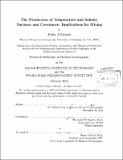| dc.contributor.advisor | Raymond W Schmitt. | en_US |
| dc.contributor.author | Schanze, Julian J. (Julian Johannes) | en_US |
| dc.contributor.other | Woods Hole Oceanographic Institution. | en_US |
| dc.date.accessioned | 2013-06-17T19:53:52Z | |
| dc.date.available | 2013-06-17T19:53:52Z | |
| dc.date.copyright | 2013 | en_US |
| dc.date.issued | 2013 | en_US |
| dc.identifier.uri | http://hdl.handle.net/1721.1/79294 | |
| dc.description | Thesis (Ph. D.)--Joint Program in Physical Oceanography (Massachusetts Institute of Technology, Department of Earth, Atmospheric, and Planetary Sciences; and the Woods Hole Oceanographic Institution), 2013. | en_US |
| dc.description | Cataloged from PDF version of thesis. | en_US |
| dc.description | Includes bibliographical references (p. 187-195). | en_US |
| dc.description.abstract | Large-scale thermal forcing and freshwater fluxes play an essential role in setting temperature and salinity in the ocean. A number of recent estimates of the global oceanic freshwater balance as well as the global oceanic surface net heat flux are used to investigate the effects of heat- and freshwater forcing at the ocean surface. Such forcing induces changes in both density and density-compensated temperature and salinity changes ('spice'). The ratio of the relative contributions of haline and thermal forcing in the mixed layer is maintained by large-scale surface fluxes, leading to important consequences for mixing in the ocean interior. In a stratified ocean, mixing processes can be either along lines of constant density (isopycnal) or across those lines (diapycnal). The contribution of these processes to the total mixing rate in the ocean can be estimated from the large-scale forcing by evaluating the production of thermal variance, salinity variance and temperature-salinity covariance. Here, I use new estimates of surface fluxes to evaluate these terms and combine them to generate estimates of the production of density and spice variance under the assumption of a linear equation of state. As a consequence, it is possible to estimate the relative importance of isopycnal and diapycnal mixing in the ocean. While isopycnal and diapycnal processes occur on very different length scales, I find that the surface-driven production of density and spice variance requires an approximate equipartition between isopycnal and diapycnal mixing in the ocean interior. In addition, consideration of the full nonlinear equation of state reveals that surface fluxes require an apparent buoyancy gain (expansion) of the ocean, which allows an estimate of the amount of contraction on mixing due to cabbeling in the ocean interior. | en_US |
| dc.description.statementofresponsibility | by Julian J. Schanze. | en_US |
| dc.format.extent | 195 p. | en_US |
| dc.language.iso | eng | en_US |
| dc.publisher | Massachusetts Institute of Technology | en_US |
| dc.rights | M.I.T. theses are protected by
copyright. They may be viewed from this source for any purpose, but
reproduction or distribution in any format is prohibited without written
permission. See provided URL for inquiries about permission. | en_US |
| dc.rights.uri | http://dspace.mit.edu/handle/1721.1/7582 | en_US |
| dc.subject | Joint Program in Physical Oceanography. | en_US |
| dc.subject | Earth, Atmospheric, and Planetary Sciences. | en_US |
| dc.subject | Woods Hole Oceanographic Institution. | en_US |
| dc.subject.lcsh | Oceanic mixing | en_US |
| dc.subject.lcsh | Ocean temperature | en_US |
| dc.subject.lcsh | Salinity | en_US |
| dc.subject.lcsh | Ocean circulation Mathematical models | en_US |
| dc.title | The production of temperature and salinity variance and covariance : implications for mixing | en_US |
| dc.type | Thesis | en_US |
| dc.description.degree | Ph.D. | en_US |
| dc.contributor.department | Joint Program in Physical Oceanography | en_US |
| dc.contributor.department | Woods Hole Oceanographic Institution | en_US |
| dc.contributor.department | Massachusetts Institute of Technology. Department of Earth, Atmospheric, and Planetary Sciences | |
| dc.identifier.oclc | 847517599 | en_US |

